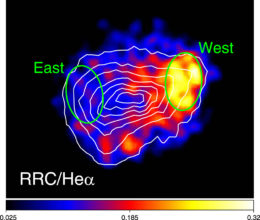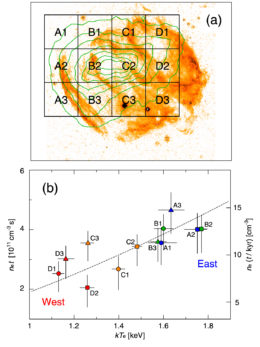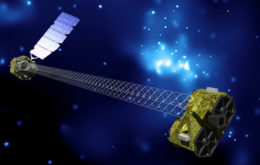There’s plenty to learn from the skeletons left behind after supernova explosions tear through their surroundings. An X-ray view from space has revealed new details about a particularly extreme supernova remnant.
Unexpected Plasmas

NuSTAR observations showing the spatial distribution of flux that indicates where overionized plasma resides in supernova remnant W49B. The overionized plasma is more highly concentrated on the western side of the remnant. [Yamaguchi et al. 2018]
We can study the young remnants of supernovae — the structures of gas and dust left behind shortly after these explosions — to learn more about how supernovae interact with the interstellar medium. One type of source is particularly intriguing: very young, hot supernova remnants that are “overionized”.
Overionized plasmas send us mixed signals: their level of ionization is higher than what we expect from the temperature we measure from their electrons. This is most likely an indication that the plasma has recently started cooling very rapidly.
But what might cause this sudden cooling of the remnant? To learn more, we need detailed observations of a young, hot remnant. Luckily, we’ve got an ideal target — and an ideal instrument.
Setting Sights
Supernova remnant W49B is one of the first sources in which we discovered signs of an overionized plasma. It’s the youngest (just ~1,000 years old!), hottest, and most highly ionized among all such objects exhibiting this trait. But W49B’s hot plasma is challenging to observe, and we haven’t yet managed to constrain its detailed high-energy properties.
A powerful telescope is up to the task, however: the Nuclear Spectroscopic Telescope Array (NuSTAR). This versatile space observatory is ideally suited for exploring the spectroscopic details of the X-rays emitted from the hot plasma in W49B.
Sudden Expansion

Top panel: Diagram of the 1’ x 1’ box regions NuSTAR resolved for spectral analysis (overlaid on a color image of W49B from the Wide Field Infrared Camera at Palomar Observatory). Bottom panel: Plot of the electron temperature (bottom) vs. the density (right) measured for each of the labeled regions. [Adapted from Yamaguchi et al. 2018]
Yamaguchi and collaborators first confirmed that the overionized plasma is most highly concentrated on the western side of the remnant. They then show that lower electron temperatures — i.e., signs of rapid cooling — are found in the same regions that also have lower density. They measure a gradient from lowest electron temperature and density in the west, to highest in the east.
Taken together with previous observations that reveal that W49B’s surroundings also have lower density on the western side, these results provide strong evidence that the remnant is cooling via adiabatic expansion. In this picture, the supernova blast wave punched through dense circumstellar matter in early stages of the explosion, expanding slowly. Now it’s suddenly breaking out into the lower-density interstellar medium — on the west side first, because it’s not exactly symmetric — leading to sudden expansion and cooling.
Does this explanation apply to overionized plasmas in the skeletons of other, similar supernovae? We’ll need more observations to be sure — but NuSTAR has proven itself up to the task!
Citation
“Evidence for Rapid Adiabatic Cooling as an Origin of the Recombining Plasma in the Supernova Remnant W49B Revealed by NuSTAR Observations,” Hiroya Yamaguchi et al 2018 ApJL 868 L35. doi:10.3847/2041-8213/aaf055


1 Comment
Pingback: Daily Study Log (2019-04-16) | Study Astrophysics